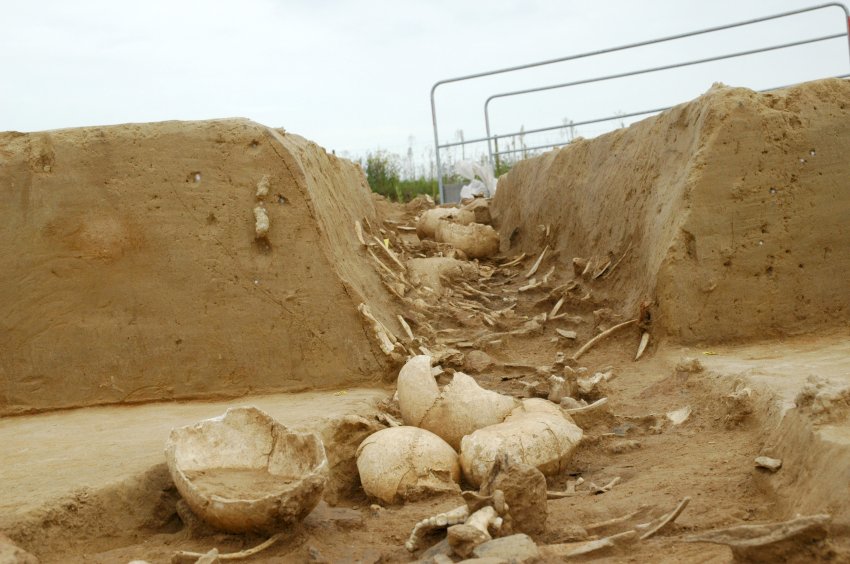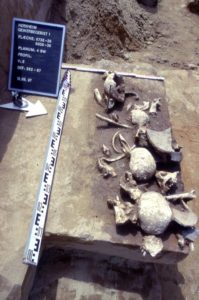Horror Archaeological Finds, Excavation in Germany Reveals Signs of Mass Cannibalism

Horror Archaeological Finds, Excavation in Germany Reveals Signs of Mass Cannibalism
A construction Team working in Herxheim, Germany, unearthed something completely stunning. Underneath the ground where they had intended to build was a huge pit brimming with dead bodies—more than 1,000 in all. How would you carve up a cow? First you cut the meat off the bones. You begin by severing the muscles from the joints with a sharp knife. The fibrous meat can then easily be scraped off, from top to Below.
After you have removed the flesh there’s still a lot of goodness left. Deep in the long bones and vertebrae lies the marrow. To get at this delicacy you smash the bone and scrape out the marrow or simply boil it out in water. What’s left is a heap of naked bones with traces of scratching and scraping as well as the small debris of bone that contained marrow.
Archaeologists discovered just such a pile — a huge one — when they were uncovering a Stone Age settlement in the small town of Herxheim in southwestern Germany. The only difference is that the bones are not from cattle. Researchers found the carefully scraped remains of some 500 people, and they have not even excavated half the site.
“We expect the number of dead to be twice as high,” Stated Andrea Zeeb-Lanz, project leader of the Cultural Heritage Agency of the state of Rhineland-Palatinate.

That’s a lot of bodies for a tiny Stone Age village. There were 10 buildings at most here in the last period of the Linear Pottery culture of the European Neolithic Age around 5,000 to 4,950 years BC.
The bodies weren’t native to this area, researchers have Found. They originated from all over Europe — from the area of what is now Paris, from the Moselle River 100 kilometers toward the northwest and even from the Elbe River valley some 400 kilometers away.
The broken bits of pottery lying between their ribs uncover their origin. It’s the so-called Linear Pottery that gave the entire population group its name: decorated with linear patterns pressed into the moist clay while it was being made.
Butchered by Experts
The strangers brought only the finest potteries from their home regions — in many cases even more beautiful than the pottery they placed inside the graves of their own dead at home.
But the pottery was crushed to pieces and scattered over the bones, along with brand new millstones and stone blades. Everything was hacked to pieces, separated, mixed together and poured into pits. The Archaeologist Bruno Boulestin conducted a close examination of the bone fragments. He published his findings from one pit 8 meters long in the latest edition of Antiquity magazine.

The pit contained a total of 1,906 bone fragments from at least 10 individuals. Two of them were infants or still born children, one was a fetus in the 34th to 36th week of pregnancy, there were two Kids aged six and 15 and six adults, at least one of whom was male.

All of them — Small Kids, children, adults — were butchered by expert hands while the bones were still fresh, as the breaks and cuts show. Boulestin concluded that the human bones bore the same marks as those of slaughtered livestock, and that the dead of Herxheim were set up as meals. He believes that marks on the bones show that body parts were cooked on skewers. His conclusions contradict other researchers who believe the meat was removed from the bones as part of a burial ritual, and wasn’t eaten.
No Signs of Battle Wounds

Who were the dead? Conquered enemies perhaps? Probably not, because the bones showed no signs of battle wounds. None of the skulls found was crushed, and there were no arrow points between the ribs.
The dead of Herxheim appear to have been in good health when they died. Their joints weren’t worn down, their teeth were in exceptionally good condition and there was no sign of malnutrition. The theory of conquered enemies also seems unlikely given that the small group of Herxheim villagers is unlikely to have vanquished people 100 of kilometers away and dragged 1,000 of them back to their little hamlet in the space of just 50 years.
“One could also imagine that individuals volunteered to come here and be ritually sacrificed,” Zeeb-Lanz told SPIEGEL ONLINE.
So what happened in Herxheim at the start of the 5th millennium BC? It’s clear that the hamlet quickly came to fame. It had been a sleepy, uneventful place since the so-called Flomborn Phase around 5,300 years BC. But around the turn of the millennium something happened that caused peoples from all over Europe to make pilgrimages to this place — a breathtaking feat of logistics and communication for that age.
Only 50 Years of Fame
But it did not last long. By 4,950 BC everything was finished. After that there were no more deaths in Herxheim because the settlement ceased to exist. It’s a baffling phenomenon for archaeologists because 50 years is an extremely short time for a place of such significance. “And 50 year is the maximum,” says Zeeb-Lanz. “It could all have happened in just 2 years or even five weeks.”
It’s clear that it was not hunger that drove the inhabitants of this mysterious hamlet to carve up humans. What they did with their victims was part of a custom, a religious ceremony. This includes the mysterious treatment of human skulls. First the skin was peeled off them. All it took was a cut across the length of the head and the skin could be peeled off the side.

Then a blow to the face at the front and the base of the neck at the back side, and two blows each at the sides — the result looks like a drinking vessel.
“But probably nobody drank from them. The edges are still so sharp today that one would cut one’s lips on them,” says Zeeb-Lanz. Archeologists found these prepared skulls heaped together in one place.
“The more research conduct, the more mysterious this place becomes.”
But did the Herxheimers truly eat up the dead? It’s impossible to prove that archaeologically. Boulestin is sure they did, but not all members of the excavation team agree with him.
Project leader Zeeb-Lanz is careful too: “We mustn’t forget that this was no giant settlement. Who is supposed to have eaten all this?”